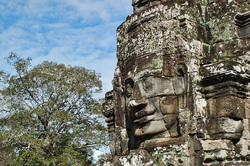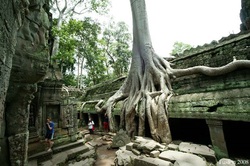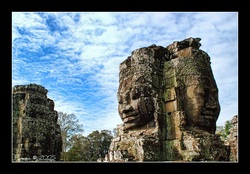The Temples of Angkor - The Best of the bunch
Getting in & getting around.
Angkor Wat

Angkor Wat which literally means ‘City Temple’ is a Hindu temple complex built to replicate the heavens on earth. Constructed for king Suryavarman II in the early twelfth century, it is the best-preserved temple and is the only one to have remained a significant religious centre since its foundation; first Hindu, dedicated to Vishnu, then Buddhist. The temple is the epitome of the high classical style of Khmer architecture.
The Bayon

The Bayon is a richly decorated Khmer temple built in the late twelfth century or early thirteenth century. Built at the centre of King Jayavarman’s capital, Angkor Thom was the last state temple to be built at Angkor, and the only Angkorian state temple to be built primarily as a Mahayana Buddhist shrine dedicated to the Buddha. Following Jayavarman’s death, it was modified and augmented by later Hindu and Theravada Buddhist kings in accordance to their religious preferences.
Ta Promh

Ta Prohm, a Bayon style temple, is believed to be built in the late twelfth and early thirteenth centuries. It was founded by King Jayavarman VII as a Mahayana Buddhist monastery and university. Unlike most Angkorian temples, Ta Prohm has been left in much the same condition in which it was found where the photogenic and atmospheric combination of trees growing out of the ruins and the jungle surroundings have made it one of Angkor’s most popular temples with visitors.
Rajavihara (Royal temple), as it was originally known, was one of the first temples founded pursuant to a massive program of construction and public works after the King’s ascension to the throne in 1811 A.D.. It was built in honor of his family. The temple’s main image, representing Prajnaparamita, the personification of wisdom, was modeled on the king’s mother. The northern and southern satellite temples in the third enclosure were dedicated to the king’s guru and his elder brother respectively. As such, Ta Prohm formed a complementary pair with the temple monastery of Preah Khan, dedicated in 1191 A.D., the main image of which represented Avelokitesvara, the Bodhisattva of compassion and was modeled on the king’s father.
The site was home to more than 12,500 people (including 18 high priests and 615 dancers), with an additional 80,000 people in the surrounding villages working to provide services and supplies.
Rajavihara (Royal temple), as it was originally known, was one of the first temples founded pursuant to a massive program of construction and public works after the King’s ascension to the throne in 1811 A.D.. It was built in honor of his family. The temple’s main image, representing Prajnaparamita, the personification of wisdom, was modeled on the king’s mother. The northern and southern satellite temples in the third enclosure were dedicated to the king’s guru and his elder brother respectively. As such, Ta Prohm formed a complementary pair with the temple monastery of Preah Khan, dedicated in 1191 A.D., the main image of which represented Avelokitesvara, the Bodhisattva of compassion and was modeled on the king’s father.
The site was home to more than 12,500 people (including 18 high priests and 615 dancers), with an additional 80,000 people in the surrounding villages working to provide services and supplies.
Angkor Thom

Angkor Thom is a very popular tourist spot. It was established in the late twelfth century to early thirteenth century by King Jayavarman VII. This site is situated 1.7 Km north of Angkor Wat, within which are located several monuments from earlier eras as well as those established by Jayavarman and his successors.
The fortified city of Angkor Thom, some 9sq km in extent, was the last and most enduring capital city of the Khmer empire built by Angkor’s greatest King, Jayavarman VII (ruled 1181-1201).
Centered on Baphuon, Angkor Thom is enclosed by a square wall 8m high and 12km in length and encircled by moat 100m wide. The city has five monumental gates, one each in the north, west and south walls and two in the east wall. In front of each gate stand giant statues of 54 gods (to the left of the causeway) and 54 demons (to the right of the causeway), a motif taken from the story of the Churning of the Ocean of Milk illustrated in the famous bas-relief at Angkor Wat. In the center of the walled enclosure are the city’s most important monuments, including the Bayon, the Baphuon, the Royal Enclosure, Phimeanakas and the Terrace of Elephants.
The fortified city of Angkor Thom, some 9sq km in extent, was the last and most enduring capital city of the Khmer empire built by Angkor’s greatest King, Jayavarman VII (ruled 1181-1201).
Centered on Baphuon, Angkor Thom is enclosed by a square wall 8m high and 12km in length and encircled by moat 100m wide. The city has five monumental gates, one each in the north, west and south walls and two in the east wall. In front of each gate stand giant statues of 54 gods (to the left of the causeway) and 54 demons (to the right of the causeway), a motif taken from the story of the Churning of the Ocean of Milk illustrated in the famous bas-relief at Angkor Wat. In the center of the walled enclosure are the city’s most important monuments, including the Bayon, the Baphuon, the Royal Enclosure, Phimeanakas and the Terrace of Elephants.

